Tracing the murky depths of the ‘well-murder’
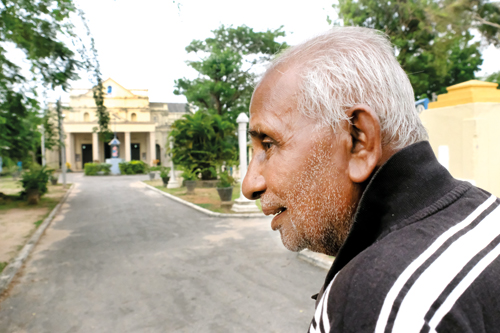
Anybody could come to church, says 85-year-old D.S.E.W Jayasuriya, with St. Rita’s Church in the background where murder most foul took place. Inset: The well now closed where Gotabhaya was found. Pix by Amila Gamage.
For whom did the bell toll?
A long time ago, nearly 53 years ago, the bell tolled for an 11-year-old boy who innocently trusted his father’s friend.
It was on an early Tuesday morn (February 8, 1966), that the sacristan (helper) of St. Rita’s Church, Ratmalana, set in a 1½-acre block of land, with the sound of waves in the background, went to the well just behind the church for a pail of water.
May be he was still half-asleep, but as the pail went down into the murky depths, it did not hit water but something else. Surprised, he rushed back to his room and armed with a torch got back to the well to shine down a light.
Imagine his horror when the most unexpected sight greeted his eyes – a body!
Things happened quickly thereafter, we hear from people around the church. The Parish Priest had to be told.
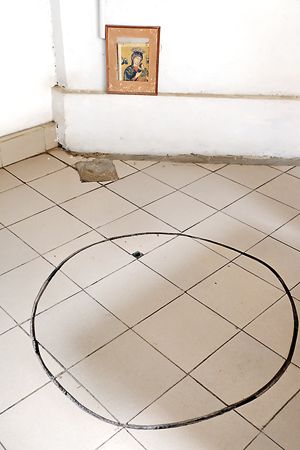 Soon after, the frantic tolling of the church bell, reminiscent of medieval times, alerted the devotees that something was amiss and they gathered, to be told of the terrible discovery. With the information being passed onto the police, the body was brought out.
Soon after, the frantic tolling of the church bell, reminiscent of medieval times, alerted the devotees that something was amiss and they gathered, to be told of the terrible discovery. With the information being passed onto the police, the body was brought out.
It was a child, in shorts and shirt, who would be identified as Ramdas Gotabhaya Kirambakanda.
For his untimely death in a watery grave, a young woman, Pauline de Croos was sentenced to death, the death penalty being upheld in appeal. Pauline, whose death penalty was commuted to a life sentence, and was finally released much later, we hear has migrated to Australia– some say she is still living there.
At the time of Gotabhaya’s murder, Pauline had been 20 going on 21. Today (November 4) is supposed to be her 73rd birthday.
Newspapers of yore dubbed it the ‘well-death’, ‘well-murder’ and the ‘boy-in-the well’ reporting the case in detail, as people in Colombo particularly Dehiwela, Mount Lavinia and Ratmalana were gripped not only by curiosity but also horror.

Gotabhaya in the school band
As we wander back down the corridors of time, firstly accessing dusty and yellowed newspapers of the time, then case records and finally following the trail to homes, school and church where the body was found, a tale of unhappy families, neglected children, questionable morals on many sides, lavish parties, a pretence of keeping up the veneer of respectability, all ending in the murder of an innocent, emerges.
“Gotabhaya and I were classmates at Hena Vidyalaya in Mount Lavinia and also played the tambourine in the school western band,” says Attorney-at-Law Damitha De Silva, producing a black-and-white photograph.
The first intimation that his classmates got that Gotabhaya was in serious trouble was when they saw a bare-chested man in sarong running straight into Principal M. Wijepala’s office, as the boys watched from their class.
“Mr. Wijepala rang the main bell a little while later and made a sombre announcement that Gotabhaya’s body had been found in a well. This was the first news we got,” says Damitha.
Earlier, we had picked up the trail of people who figured in this long-ago murder down Quarry Road, snaking parallel to Allan Avenue, behind the rear wall of the Dehiwela Zoo.
“Yes, my mother had rented her upstair house to the Croos family. This is the house. Soon after the incident, the de Croos family left. Now, however, the house looks different as it has been renovated. Earlier, it had been a parana thale geyak (old fashioned house), an upstair made of kabok with an arch at the front,” says the daughter, adding that her mother used to speak of the case which took Dehiwela by storm.
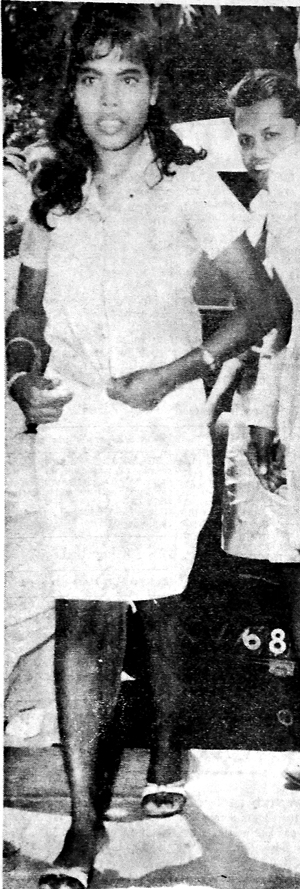
Pauline de Croos on the day when she hears that the death sentence against her is upheld and she has lost her appeal. (SUN – May 25, 1968)
The schoolbag of Gotabhaya had been found in a garden quite close to the de Croos home.
Our next stop is Kawdana Broadway, where the Kirambakanda family lived, once again on rent – father Bodhipala, mother Jessica, youngest child Gotabhaya and his two older sisters.
A school at the top of the road is just concluding its lessons and children, both boys and girls, rush out happy to be out of class.
Images of Pauline, going to another school, Hena (now Lalith Athulathmudali) Vidyalaya in Mount Lavinia and taking Gotabhaya out during the interval on some excuse, comes into our mind’s eye.
Many are the old timers in Kawdana who confirm that they knew the Kirambakanda family very well and also saw Pauline visiting their home.
“Ee podi lamaya (Gotabhaya) ape watta udin thama iskole giye,” says Sumathipala, explaining that the child went to school through his property. He shows us the area where the adi para (footpath) had been.
There were few houses then and those houses were not surrounded by walls like now, we are told, but had weta (fences). Everyone lifted the barbed wire and crept through into each other’s properties.
Little details not mentioned in the newspapers but which had been the talk in hushed tones among the neighbours of those days, we hear. There were many squabbles between Bodhipala and Jessica, but all are insistent that both Bodhipala and Jessica loved Gotabhaya very much.
“This was a quiet neighbourhood,” say others, but the Kirambakanda home was a hive of activity, as parties were galore with high profile personalities dropping by often. Pauline was also a frequent visitor.
After the murder of Gotabhaya, the rumour mill worked overtime, with suggestions that someone had placed a lot of money (Rs. 50,000, a princely sum in the 1960s) for the welfare of the boy and he was killed to get at that money. It seemed like a botched up kidnapping, they still speculate, adding that two others were also said to be involved. The story goes that Pauline took Gotabhaya from school, drugged him and was seen praying at St. Rita’s with the boy next to her on a pew. Later, she had been seen with the boy at the well, but there are no clues whether she carried him or was helped by someone.
It transpired in the evidence of a Medical Officer of the Colombo South Hospital that in January or early February, Pauline came to him and complained of sleeplessness and headaches. He prescribed three pills. Witness had known her for about a year before she came to get medicine and sometimes he had seen Kirambakanda at her place.
“Though my brother was slightly older, he and Gotabhaya were close friends and Gotabhaya was in and out of our house. He used to have his meals with us,” said an old resident, adding that “re wenakan apith ekka innawa (he used to be with us till night)”.
Even on the day of the tragedy, their brother and Gotabhaya went to school the same way they had been doing over the years. They walked up to Dehiwela Junction, Gotabhaya turned left to board a bus for Mount Lavinia and their brother turned right and headed for Isipathana.
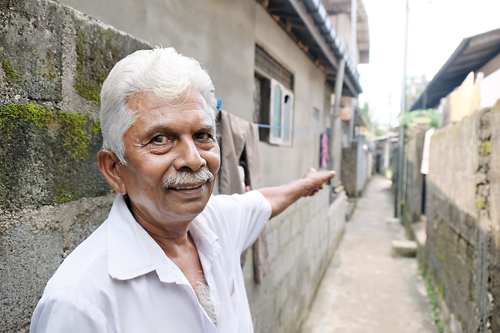
This is where the ‘adi para’, was says Sumathipala
The day before Gotabhaya’s disappearance, their brother and Gotabhaya had done some work in the garden, planting a kehel pele (plantain tree) close to the Maha Gedera. The mammoty (kotapu udella) was there, where they had left it, even during the boy’s funeral, said the resident, recalling that their brother did not eat his meals for about a week as he was very upset over Gotabhaya’s death.
Kawdana was rural then – lots of paddyfields and Broadway had a kurundu kelle (cinnamon jungle), an abundance of coconut and kitul palms, as well as dang and ma-dang trees.
“Wetawal waling penala, lamai niyara uding duwala, sellam karanawa,” the resident says, adding that the children would jump over fences and run along the niyara.
Gotabhaya was a thin lad, a nice boy, is what everyone says.
We speak to another family which says that Bodhipala was a businessman dealing in ornamental fish and Jessica was “hari lassanai” in her osariya.
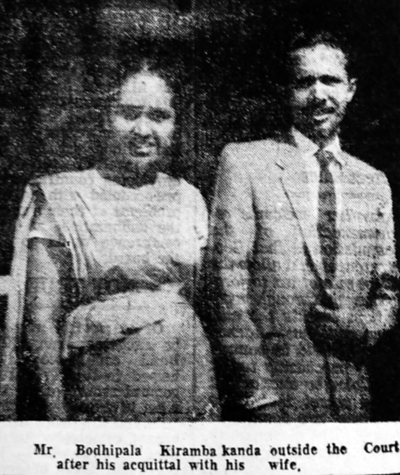
Bodhipala Kirambakanda outside court, with wife Jessica, having been discharged in the case. (SUN--March 2, 1968)
They add that even on the day that Gotabhaya disappeared, “roti kala ape watta udin thama giye hathe bus eka allanna (he ate roti and went across our garden to catch the 7 o’clock bus)”.
When the news came that a body had been found in a well in a churchyard, it was another resident who was about 20 years old at that time who took Bodhipala to the Lunawa Hospital to identify the body.
“I drove my father’s car there. We walked into a room and saw Gotabhaya’s body. Bodhipala broke down, keeping his head on my shoulder and vowing revenge against those responsible,” he says. He was also present at the inquest.
When Gotabhaya’s bag was recovered, once again it was this 20-year-old who took Jessica to the Dehiwela Police Station to identify it. “It was a small suitcase and his books were in it. There was a postcard indicating a song that he wished to be played on a musical programme, with his two sisters names on it.” (It was an era when there were no TVs, only radios and people could write in requesting the radio station to play a song of their choice.)
Pauline miniyata ava, scarf ekak bendagena, others recall, having seen Pauline coming for the funeral wearing a scarf.
Sometime later they heard a commotion at the Kirambakanda home, to find that Bodhipala was being arrested. Thereafter, the owners of the house had got the Fiscal to throw out the Kirambakanda family – with people seeing their stuff lying on the road.
The house still stands, looking slightly abandoned and we hear that there is a single boarder there.
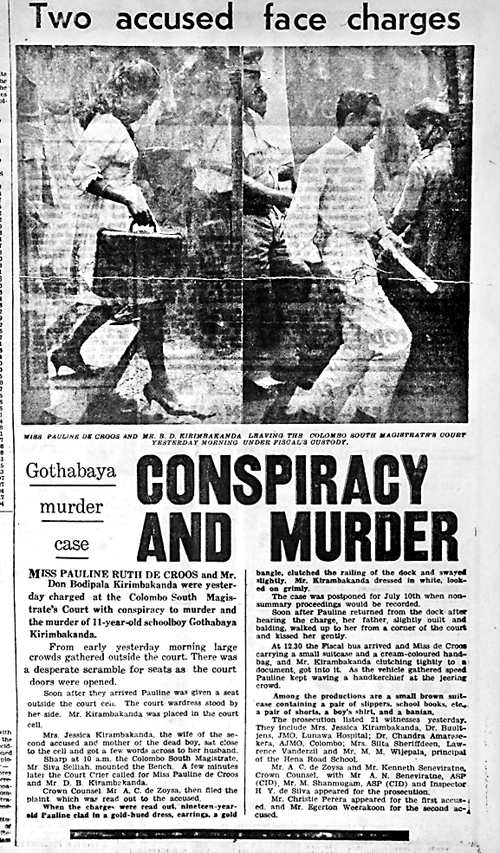
Pauline de Croos and Bodhipala Kirambakanda in Fiscal custody after plaints have been filed against them. (Ceylon Daily Mirror--July 1, 1966)
Onto St. Rita’s Church we head, and people tell us how they had seen Pauline there on many days, seated on a pew at the back. “The case created an aandolanaya (furore) in those days.”
We get the scene of those times – the beautiful little church, compared to its more magnificent sisters and the Mission House where the priest resides being just a tiny room.
“The church was always open like all Roman Catholic churches. Anybody could come here, pray and leave,” says D.S.E.W. Jayasuriya (85), adding that the incident took place on a weekday and people had seen Pauline with Gotabhaya, sitting inside the church.
When the boy’s body was taken out of the well, the bell was rung and people gathered at the church. The police were informed thereafter. Parish Priest Fr. Hebastraw immediately ordered the closure of the well, he says.
With the parishioners being upset over the incident, the church had undergone a name-change from St. Rita’s to St. Mary’s.
As we leave, we see two boys, may be slightly younger than Gotabhaya playing in the churchyard oblivious of the tragedy that occurred here nearly 53 years ago.
According to reports on the court case a doctor had given evidence that the boy was alive when he hit the water in the well. Death was due to asphyxia from drowning…….the stomach contents were three to four ounces of odourless liquid. The boy would not have had a meal for about seven or eight hours before death. The boy would have been dropped into the well after 3.30 p.m. on February 7 and before 3.30 a.m. the following morning (February 8).
A young life snuffed out – was it for illicit love or was it for money? Was it a kidnapping gone wrong? Was it only Pauline who was involved or were there others? Was Pauline innocent and was there a miscarriage of justice?
Many are the secrets forever lost with Gotabhaya, whose father had insisted on cremating him.
| Chronology of events: | |
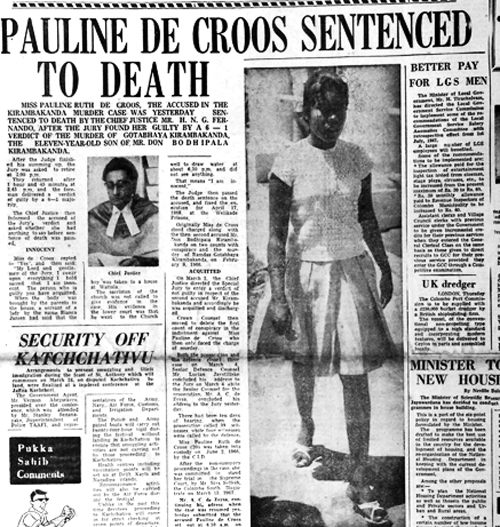 Pauline de Croos is given the death penalty (SUN – March 8, 1968) A chronology of events garnered from ‘Facets of the Criminal Law’ by former Supreme Court Judge A.C. Alles and newspapers of 1966-1968. February 7, 1966 (Monday) – 11-year-old Gotabhaya Kirambakanda does not return home to Kawdana after lessons at Hena Vidyalaya, Mount Lavinia. February 8, 1966 — Gotabhaya’s body is found around 6.30 a.m. in a well at St. Rita’s Church, Ratmalana. The first postmortem is conducted at the Lunawa Hospital at 3.30 p.m. – The findings indicate it is a drowning and that rigor mortis (stiffness of death) had set in. February 9, 1966 – On the request of relatives suspecting foul play, a second postmortem is conducted. This finds two contusions (bruises) on the top of Gotabhaya’s head presumed to be a result of club blows or caused by struggling in the water. June 2, 1966 — Pauline Ruth de Croos is arrested by the Criminal Investigation Department — CID. June 24, 1966 – CID completes the investigations. June 30, 1966 – Plaints against Pauline and Gotabhaya’s father, Don Bodhipala Kirambakanda, are filed in the Colombo South Magistrate’s Court — conspiracy to murder and the murder of Gotabhaya. The non-summary proceedings are heard by Magistrate Siva Selliah. Crown Counsel A.C. de Zoysa and Kenneth Seneviratne with CID ASPs A.M. Seneviratne and N. Shanmugan and Inspector H.Y. de Silva appear for the prosecution. Defence Counsel Christy Perera appears for Pauline and Egerton Weerakoon and Siri Perera for Kirambakanda. “Pauline clad in a gold-hued dress, earrings, a gold bangle, clutched the railing of the dock and swayed slightly. Kirambakanda dressed in white looked on grimly, when the charges were read out,” newspapers state. March 1967 – Magistrate Selliah commits the first accused Pauline and second accused Kirambakanda to the Colombo Assizes. They are tried before Chief Justice H.N.G. Fernando and a special seven-member English-speaking Jury. March 2, 1968 – Kirambakanda is discharged on the ground that there is no evidence upon which he could be convicted. One of the charges brought against Pauline — conspiracy to murder — is removed. March 7, 1968 – Pauline is found guilty by the all-male Jury on a divided verdict of 6 to 1. She is then sentenced to death. “After sentence of death was pronounced on Pauline, she walked expressionless and quiet to the Black Maria through a jeering and unsympathetic crowd. It was not until the next day, when she woke up in Death Row that she wept bitterly, perhaps at the grave injustice she had suffered. Her sentence was respited by the Governor-General and she remained a model prisoner and is now out of prison and happily married but the traumatic experiences she underwent will probably haunt her for the rest of her days,” says ‘Facets of the Criminal Law’ by A.C. Alles April 17, 1968 – Pauline’s execution is set for this date at the Welikada Prisons. May 24, 1968 – Pauline’s appeal is dismissed by the Court of Criminal Appeal. Of the three-judge bench, Justice T.S. Fernando (President) and Justice Tambiah rule in favour of the earlier verdict, while Justice Sirimane gives a dissenting view over the question of admissibility/inadmissibility surrounding evidence of bad moral character of the accused. (C.C.A Appeal of No. 18 1968 with Application No. 22 of 1968) May 1969 – The then Governor General William Gopallawa commutes Pauline’s death sentence to life imprisonment, on the advice of Justice Minister Fairlie Wijemanne. 1980 — Pauline is reportedly released from prison after serving 14 years, since her arrest by the CID on June 2, 1966. In the Colombo Assizes, Crown Counsel A.C. (Bunty) de Zoysa and Kenneth Seneviratne appeared for the prosecution. Senior Counsel Lucian Jayatilleke defended Pauline de Croos, with Counsel Y.G.P. Perera, Tyronne Fernando (assigned) instructed by R.D. Dharmaratne and Jayantha de Gunasekara appearing for her. Queen’s Counsel G.E. Chitty defended Kirambakanda. Meanwhile, in the Court of Criminal Appeal, Senior Crown Counsel V.A.S. Pullenayegam and Crown Counsel Kenneth Seneviratne and L.D. Guruswamy appeared for the Crown. G.E. Chitty QC, E.R.S.R. Coomaraswamy, A.M. Coomaraswamy, Anil Obeyesekere, P. Chakradaran, Kumar Ameresekere, Tyronne Fernando, Rajah Gunaratne instructed by R.D. Dharmaratnam and Jayantha de Gunasekara appeared for Pauline. |
| Mysterious sightings | |
| Oft there were “sightings” of a boy in shorts and shirt carrying his schoolbag, signalling for a lift at the top of Kawdana Broadway, soon after Gotabhaya’s funeral, we hear from many in the now-fully built up vicinity.Those were the days when the area was sparsely inhabited – homes on large properties, Broadway winding this way and that, sandwiched by shrubs and large trees.One particular incident is vivid in the minds of many. A doctor living in the area had been returning home in his car around midnight when a schoolboy had put out his hand for a lift. Wondering what the boy was doing on the road so late, the doctor had obliged and the boy had climbed onto the backseat. To his queries, what he was doing out of home, there had been only a defeaning silence. When getting close to his home, the doctor had informed the boy that he’d have to drop him off and looked over his shoulder, only to find that he had been talking to thin air – the boy had vanished without a trace! That had been so chilling that the doctor had taken to his bed with a high fever and the family had sold their home and migrated to Australia soon after.
|


